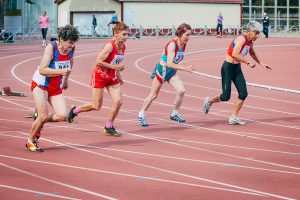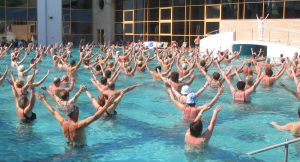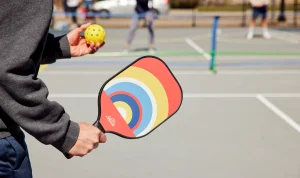6 Chapter 6- Aging In Sport
CHAPTER 6- AGING IN SPORT
How Sport Shapes the Experience of Ageing
Today, old age is often shown in two main ways in society. The first is an opposing view that sees older people as fragile, dependent, and slowing down. This stereotype has existed for a long time and continues to influence how we perceive and treat aging. For example, it’s common to think that older adults should avoid physical activity or that they can’t do things like play sports or stay active. But there’s also a more modern and positive image of old age, where older people are seen as active, healthy, and even adventurous. This is what some scholars, like Pike, call a “heroic” view of ageing. It shows older people running marathons, lifting weights, or doing yoga, which challenges the traditional idea of ageing as only about decline. However, this positive image can also create pressure, because it suggests people must stay young and fit to be valued. So, in today’s society, old age is caught between these two images—one that limits people and another that celebrates them, but sometimes in unrealistic ways.
When the article says that sport helps older people to “accept and resist the ageing process,” it means that sport allows them to recognize the changes in their bodies while still staying active and pushing their limits. Accepting ageing means understanding that your body may not work the same way it did when you were younger. For example, you might not run as fast or lift as much weight. But sport also allows people to resist ageing by staying physically strong, mentally sharp, and socially involved. It gives older adults a sense of control and purpose. Playing sports can help them feel younger and more confident. So, even if they accept some physical changes, they don’t have to give in to the idea that getting older means becoming weak or invisible. Sport becomes a tool that helps people both adjust to ageing and fight against the negative effects that come with it.


According to Elizabeth Pike, not everyone has equal access to sport and physical activity in later life, and this inequality is shaped by social and economic factors. Some of the groups that are most disadvantaged include older adults with disabilities, those who are physically frail, people living in rural areas or care homes, and individuals from ethnic minority backgrounds. These groups often face barriers such as limited transportation, lack of nearby facilities, or cultural and language differences that make it harder for them to feel included in mainstream sports programs. For example, an elderly person living in a small rural town might not have access to a gym or a senior exercise group, while someone living in a care home may depend on staff to arrange or allow participation in any physical activity.
Pike also draws attention to how gender plays a big role, especially in the case of older women. Many older women are expected to continue caregiving roles, looking after grandchildren, spouses, or even their own aging parents. This unpaid care work leaves them with little time, energy, or support to take part in sport or recreation. In addition, women often experience societal expectations about how they should act and look as they age, which can lead to embarrassment or discomfort in public exercise settings. For example, an older woman might avoid going to the pool because she feels judged in a swimsuit, or might not feel confident joining a mixed-age gym class where she sees mostly younger, fitter people.
Privilege, meaning access to money, time, education, and social support, makes a huge difference in who gets to age actively. Wealthier older adults who are white and middle-class are far more likely to have gym memberships, personal trainers, or live in communities that offer fitness classes designed for seniors. They are also more likely to see people like themselves being celebrated in the media as examples of “active ageing,” which can motivate them to stay engaged. In contrast, people with fewer resources may not only lack physical access to facilities but also feel culturally excluded, as their stories and experiences are often not reflected in mainstream fitness culture or research.
Pike points out that most studies about ageing and sport focus on this privileged group white, middle-class, healthy people which means we don’t fully understand the struggles or needs of other groups. This is a serious problem because it limits our ability to create fair and inclusive sport programs. Sport in later life should not be seen only as a matter of personal health or motivation, but as a social justice issue. To make sport more accessible and meaningful for everyone, we need to consider how race, gender, income, ability, and location affect older people’s chances to be active. True inclusion means designing sport environments that are welcoming, affordable, and culturally respectful for all older adults, not just the most privileged few.
Comparing Inclusivity and Age Representation in “This Girl Can” and “You Can’t Stop Us”
When I compare the two ads, “This Girl Can” by Sport England and “You Can’t Stop Us” by Nike, I notice some big differences in their focus and who they include. “This Girl Can” feels much more personal and real. It shows everyday women doing all kinds of physical activity like jogging, swimming, dancing, even if they don’t look like traditional athletes. Some are older, some are bigger, and some just look like regular people we might see in our neighborhood. I find that really powerful because it shows that sport and movement aren’t just for the young or super fit. It’s for everyone.
On the other hand, “You Can’t Stop Us” is more about big, dramatic moments. It’s full of famous athletes doing amazing things, and it mixes in a strong message about unity and overcoming struggles. It includes people of different races, genders, and abilities, which is great to see. But I didn’t really notice any older people, especially older women, in the ad. Most of the athletes seem young and at the top of their game. That makes it inspiring, but also a bit less relatable for someone who’s not a pro or not in their 20s.
I think “This Girl Can” is more inclusive when it comes to age. It actually shows older women being active and enjoying it, even if they’re sweating, jiggling, or just having fun. That really connects to what Elizabeth Pike talks about in her article, where she says that aging has been “feminized” because more women are living longer, but they often get left out of sports. This ad fights back against that idea by showing older women being active and proud. It says, “You can do this too,” no matter your age or shape.
In contrast, “You Can’t Stop Us” doesn’t show that kind of everyday experience. It’s exciting and emotional, but it focuses more on professional athletes and intense performances. It doesn’t really show the struggles or realities that come with ageing, like slowing down or being judged. So, while it’s inclusive in many ways like showing disabled athletes and people from different backgrounds, it doesn’t really challenge the age stereotypes that Pike writes about.
In the end, I believe “This Girl Can” does a better job of including all kinds of women, especially older ones. It feels honest, encouraging, and down-to-earth. “You Can’t Stop Us” is powerful too, but it’s more about perfection and performance. If we really want to change how society sees ageing, especially for women, we need more campaigns like “This Girl Can” that celebrate all bodies and all ages just the way they are.
Yes, I do agree that aging has been “feminized” in some ways, especially based on what Elizabeth Pike discusses in her article “Assessing the sociology of sport: On age and ability.” She explains that more women are living longer than men, which leads to more older women making up the ageing population. Because of this, we now see ageing being more associated with women and their experiences, especially in the later stages of life.
One reason I think aging has been feminized is because older women often face unique challenges that men may not deal with as much. For example, the article mentions how older women are expected to continue their roles as caregivers, for their grandchildren or even their own elderly parents. This shows that even in older age, women are still shaped by traditional gender roles, and their time and energy are often used to support others rather than themselves. This makes it harder for them to focus on things like their own physical activity or joining sports.
Another point is that women tend to live longer but often with fewer resources. Pike says that older women are sometimes isolated due to widowhood or live with limited economic and cultural support. This can make them less able to stay involved in sports or other active lifestyles. And even if they are active, the way society views older women often creates extra pressure like needing to look younger or stay thin, not just to be healthy, but to still meet beauty standards. This pressure can make ageing feel like something women have to hide or fight against, instead of accept or celebrate.
The article also says that sport opportunities for older people tend to be shaped by stereotypes. Women may feel embarrassed or unsure about being active because society often sees older bodies, especially female ones, as fragile or less capable. That’s why many older women prefer sports environments that are social, gentle, and non-competitive, like group fitness classes or even active video games at home, instead of harsh physical training.
In contrast, men might be more encouraged to stay competitive or strong in older age, like in Masters competitions. This shows a difference in how we view older men and older women in sport, another reason why ageing seems more “feminized.” Older women are more visible in conversations about the burdens and care roles in ageing, but less visible as athletes or active individuals.
So, overall, I believe ageing has been feminized because more women live into old age, but also because society places different expectations on them. Their experiences are shaped by gender roles, lack of access to resources, and stereotypes about what older women should or shouldn’t do. Pike’s article really helped show how these patterns affect how we see ageing, and why we need to think more carefully about them, especially in the world of sport.
Longer Prompt
Pickleball and the Changing Narrative of Ageing in Sport

The rise of pickleball as a popular sport trend, especially among older adults, highlights a significant shift in how society views ageing and physical activity. As Elizabeth Pike discusses in her article on the sociology of sport, age, and ability, older people have often been marginalized in sporting spaces, seen as physically declining and less capable of engaging in active lifestyles. However, pickleball challenges these outdated views by offering a game that is easy to learn, low-impact, and enjoyable across a wide range of ages and abilities. The sport’s structure, played on a smaller court with a slower pace, makes it ideal for older individuals who want to stay active without overexertion. This allows many seniors to maintain their physical competence and resist the notion that ageing necessarily means frailty or inactivity.
Beyond its physical accessibility, pickleball also fosters strong social bonds, which is another key reason for its appeal to older adults. Pike emphasizes the importance of social inclusion for ageing populations, noting how many older people face isolation or lack of encouragement when it comes to physical activity. Pickleball addresses this gap by creating vibrant, welcoming communities where players connect through friendly competition, shared interests, and regular interaction. According to recent Canadian surveys, enjoyment was the top reason people play the sport, followed closely by health benefits and social engagement. The sport becomes more than just exercise, it becomes a social ritual and support system that gives many older adults a renewed sense of purpose and community.
Pickleball also aligns with Pike’s concept of the “third age,” a stage in life post-retirement where individuals seek to remain active and independent. The game offers a perfect blend of leisure and challenge, allowing older adults to express vitality and agency. It has become not just a sport but a lifestyle for many, especially in retirement communities and recreation centers. Facilities are being redesigned around it, and community events often center on pickleball, showing how deeply it has embedded itself into older adults’ routines. In doing so, pickleball redefines what it means to grow old, it shows that later life can be active, sociable, and meaningful.
However, as Pike warns, we must not overlook the inequalities in access and participation. Despite pickleball’s growing popularity, barriers still exist. The recent Canadian survey found that a lack of information and shortage of facilities were the main challenges for many potential players. Pike adds that those from lower-income backgrounds, rural areas, or minority communities often face the most difficulties in accessing sport. While pickleball has made great strides in inclusivity, these gaps show that the sport, like society, still has work to do in ensuring all older adults can benefit equally.
In conclusion, pickleball represents a positive shift in how sport and ageing are connected. It resists old stereotypes by promoting activity, community, and empowerment among older adults. Yet, as Pike emphasizes, we must continue to critique the social structures around ageing in sport, ensuring that participation is not driven by pressure to “stay young,” but by genuine inclusion and the celebration of ageing in all its diverse forms.
Sources used
Amy. (2024, November 29). The Future of Pickleball: Beyond the Court. Kayimission.org. https://kayimission.org/the-future-of-pickleball-beyond-the-court/?gad_source=1&gclid=CjwKCAjw–K_BhB5EiwAuwYoyo6nr2-AIkLTJB8KivKsgS1G0bcTYpoonrcwDmjlyanD5uZr29Jf5RoCnsAQAvD_BwE
Canada’s New Favourite Sport? The Rapid Rise of Pickleball – MYPROTEINTM. (2024, October 14). MYPROTEINTM. https://ca.myprotein.com/blog/current-events/pickleball-the-fastest-growing-sport-in-america/
Pickleball in Canada – January 2025 Survey – Pickleball Canada. (2025). Pickleballcanada.org. https://pickleballcanada.org/pickleball-in-canada-january-2025-survey/
Media Attributions
- Depositphotos_82766666_xl-2015
- sxc-seniors-water-fitness-915227_59731382
- Screen_Shot_2023-07-20_at_12.25.24_PM
